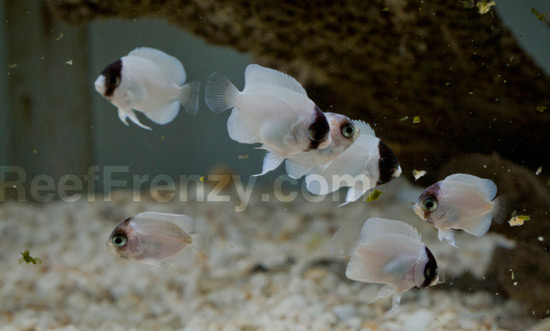Certain marine fish are so uncommon in the aquarium hobby yet so beautiful to behold that they fetch an absolutely mind-blowing price (sometimes in the many thousands of dollars for a single specimen) when they do make a rare appearance in the trade. Among these “Holy Grail” species is Genicanthus personatus, the masked angelfish.
Now, thanks to the tireless efforts of biologist Karen Brittain of the Hawaii Institute of Marine Biology—and as was revealed with much fanfare at this year’s MACNA conference in Denver—this virtually unattainable Hawaiian endemic has been successfully spawned in captivity, bringing it at least one step closer to accessibility within our hobby.
Beauty unmasked
Though not garishly colored like so many reef fishes, G. personatus is a real “looker” nonetheless. Juveniles are pearly white overall with a starkly contrasting black “mask” obscuring the face. Mature specimens are sexually dichromatic. Females maintain much of the dark mask and exhibit a broad black band on the tail and yellow coloration on their pectoral and pelvic fins. Males also exhibit the black tail band and yellow paired fins, but their face turns yellow and their dorsal and anal fins develop yellowish-orange coloration on the margins.
Out of their depth
But why so rare and costly? In the area of Hawaii where it’s legal to collect this species, G. personatus occurs in very deep water. In fact, it was at a depth in excess of 400 feet that deepwater diver Rufus Kimura, using rebreather technology, collected the brood pair for Brittain last December.
A tip of the hat to Reef Frenzy®
In a video describing the breeding project, Brittain notes that there were some stressful moments early on. The male didn’t settle in well and refused to eat. She credits Larry DuPont and his LRS Reef Frenzy® foods for finally initiating a feeding response from the male (Reef Frenzy® foods were also the first non-live foods offered to the juveniles). The pair, dubbed Jumbo and Hina, spawned on March 2.

Unprecedented survivorship
Actually, this latest spawning was Brittain’s second with this species. She last bred G. personatus over 10 years ago while working at the Waikiki Aquarium, but only one fish was raised from that spawning. The recent spawning event yielded a much more significant quantity of surviving offspring. In fact, she describes this larval rearing run as her most successful to date in terms of survivorship.



